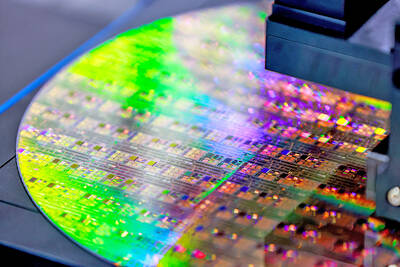The prices of computer memory chips, or dynamic random access memory (DRAM), held steady yesterday ahead of an announcement later this week on the government’s planned industrial integration scheme.
The spot price of the benchmark DDR 512Mb 128x8 eTT memory chips was unchanged at US$0.83 per unit yesterday from Tuesday, real-time price information on market researcher DRAMeXchange Technology Inc’s (集邦科技) Web site showed.
The government is expected to unveil an integration plan involving the creation of a DRAM company with initial capital from the government to help the industry’s long-term development and secure advanced technologies from foreign partners such as Japan’s Elpida Memory Inc and US company Micron Technology Inc.
The Ministry of Economic Affairs is scheduled to submit a consolidation plan to Premier Liu Chao-shiuan (劉兆玄) today, the Chinese-language United Evening News reported yesterday, citing Minister of Economic Affairs Yiin Chii-ming (尹啟銘).
Fielding questions from lawmakers at the Legislative Yuan’s Economics Committee, Yiin said the ministry would not make public whether the government favored a group led by Elpida or a group led by Micron for the industry consolidation, the newspaper said.
The ministry will only release a framework for the consolidation and a candidate appointed by the government to help push forward the consolidation, the paper quoted Yiin as saying.
As Taiwanese DRAM makers are the major suppliers on the spot market, rather than selling chips on a contract basis like their foreign rivals, any consolidation speculation could swing the price trend, the Taipei-based research house said.
“The price of DRAM chips may go back to the fundamentals” once the government announces its plans to steer the integration of the nation’s DRAM industry, DRAMeXchange said in a report dated Tuesday.
Over the past weeks, the price trend of DRAM chips became more volatile as wild speculation about a variety of consolidation scenarios swirled in the market, DRAMeXchange said.
Last week, the spot price of DRAM plummeted 10.53 percent to US$0.85 per unit, from US$0.95 during the week ending on Feb. 24, the weekly DRAMeXchange report said.
In expectation of bailout funding and a possible further decrease in chip supply in the wake of consolidation, shares of the nation’s unprofitable DRAM makers Powerchip Semiconductor Corp (力晶半導體), Nanya Technology Corp (南亞科技) and Inotera Memories Inc (華亞科技) jumped by 1.58 percent, 6.35 percent and 4.95 percent respectively, to NT$3.86, NT$6.36 and NT$11.65 yesterday.
The stock price of debt-ridden ProMOS Technologies Inc (茂德科技) plunged 6.35 percent as it was forced to extend an early tender offer to buy back its convertible bonds at a premium to March 17 from March 2 as it failed to win 86 percent of its investors’ support for the buyback offer.

Taiwan’s rapidly aging population is fueling a sharp increase in homes occupied solely by elderly people, a trend that is reshaping the nation’s housing market and social fabric, real-estate brokers said yesterday. About 850,000 residences were occupied by elderly people in the first quarter, including 655,000 that housed only one resident, the Ministry of the Interior said. The figures have nearly doubled from a decade earlier, Great Home Realty Co (大家房屋) said, as people aged 65 and older now make up 20.8 percent of the population. “The so-called silver tsunami represents more than just a demographic shift — it could fundamentally redefine the

Businesses across the global semiconductor supply chain are bracing themselves for disruptions from an escalating trade war, after China imposed curbs on rare earth mineral exports and the US responded with additional tariffs and restrictions on software sales to the Asian nation. China’s restrictions, the most targeted move yet to limit supplies of rare earth materials, represent the first major attempt by Beijing to exercise long-arm jurisdiction over foreign companies to target the semiconductor industry, threatening to stall the chips powering the artificial intelligence (AI) boom. They prompted US President Donald Trump on Friday to announce that he would impose an additional

China Airlines Ltd (CAL, 中華航空) said it expects peak season effects in the fourth quarter to continue to boost demand for passenger flights and cargo services, after reporting its second-highest-ever September sales on Monday. The carrier said it posted NT$15.88 billion (US$517 million) in consolidated sales last month, trailing only September last year’s NT$16.01 billion. Last month, CAL generated NT$8.77 billion from its passenger flights and NT$5.37 billion from cargo services, it said. In the first nine months of this year, the carrier posted NT$154.93 billion in cumulative sales, up 2.62 percent from a year earlier, marking the second-highest level for the January-September

Asian e-commerce giant Shein’s (希音) decision to set up shop in a historic Parisian department store has ruffled feathers in the fashion capital. Anger has been boiling since Shein announced last week that it would open its first permanent physical store next month at BHV Marais, an iconic building that has stood across from Paris City Hall since 1856. The move prompted some French brands to announce they would leave BHV Marais, but the department store had already been losing tenants over late payments. Aime cosmetics line cofounder Mathilde Lacombe, whose brand was among those that decided to leave following